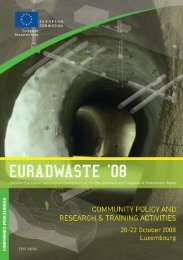EU industrial structure - EU Bookshop - Europa
EU industrial structure - EU Bookshop - Europa
EU industrial structure - EU Bookshop - Europa
You also want an ePaper? Increase the reach of your titles
YUMPU automatically turns print PDFs into web optimized ePapers that Google loves.
<strong>EU</strong> <strong>industrial</strong> <strong>structure</strong> 2011 — Trends and Performance<br />
for technology and technological developments. Patent<br />
statistics refer to the output of the research process<br />
undertaken by firms and sectors. They provide information<br />
on a large number of sectors and technologies and they<br />
permit good coverage of developments over time, which<br />
is particularly interesting. As these data are available for<br />
a large number of countries, it is possible to calculate the<br />
relative performance of the <strong>EU</strong>, or any other country or<br />
region relative to the world.<br />
Two sectoral indicators based on the number of patents<br />
are used in this section. The first indicator, PAT1, compares<br />
patent intensity across <strong>industrial</strong> sectors in the <strong>EU</strong>. It is<br />
computed as the ratio of patents to employment in a sector,<br />
relative to the same ratio for total manufacturing:<br />
where:<br />
PAT : patents filed by <strong>EU</strong> sector ‘i’<br />
i,<strong>EU</strong><br />
PAT : patents filed by <strong>EU</strong> ‘all sectors’<br />
T,<strong>EU</strong><br />
L : employment in <strong>EU</strong> sector ‘i’<br />
i,<strong>EU</strong><br />
L : total employment in the <strong>EU</strong><br />
T,<strong>EU</strong><br />
Values greater (lower) than 1 indicate that the sector is<br />
more (less) patent‑intensive than the whole economy (and<br />
therefore than all other sectors). The indicator is calculated<br />
82<br />
using data from both the European Patent Office (EPO) and<br />
the US Patent Office (USPO).<br />
The second indicator, PAT2, compares the number of<br />
patents in a given sector in the <strong>EU</strong> relative to total patents in<br />
the <strong>EU</strong> with the number of patents in the same sector in the<br />
world relative to total patents in the world. It is therefore,<br />
an indicator of the <strong>EU</strong> sector’s relative performance in<br />
patenting. It is defined by the following ratio:<br />
where:<br />
PAT : number of patents filed by <strong>EU</strong> sector ‘i’<br />
i,<strong>EU</strong><br />
PAT : number of patents filed by <strong>EU</strong> ‘all sectors’<br />
T,<strong>EU</strong><br />
PAT : number of patents filed by world sector ‘i’<br />
i,W<br />
PAT : number of patents filed by world ‘all sectors’<br />
T,W<br />
Values greater than 1 indicate that the sector has a ‘patent’<br />
specialisation relative to the rest of the world. 53<br />
As PAT1 reflects the number of patents in a sector relative<br />
to employment, it measures patenting intensity across<br />
sectors. 54 As was the case with R&D, this varies substantially<br />
across sectors, from the highest values in two ICT sectors<br />
(office machinery and telecommunications equipment)<br />
to the near‑negligible value for clothing, wood and wood<br />
products, and printing and publishing, cf. Figure III.20.<br />
53 Some studies normalise the specialisation indices such that the<br />
specialisation indices are bounded between -1 and 1. A figure<br />
with normalised indices looks identical as figure III.17 though<br />
re-scaled.<br />
54 The ranking is based on the data from EPO.
















